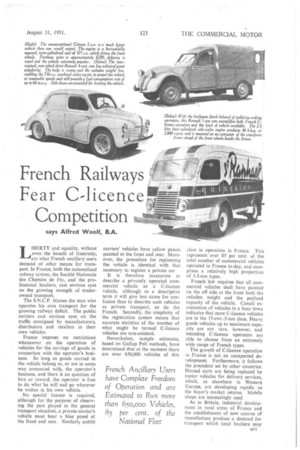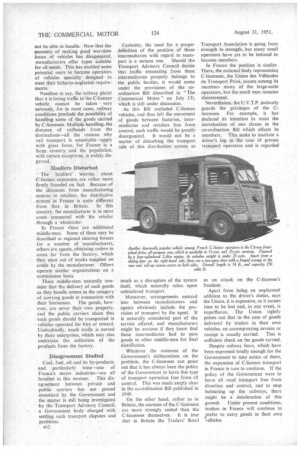French Railways Fear C-licence Competition
Page 45

Page 46

If you've noticed an error in this article please click here to report it so we can fix it.
says Alfred Woolf, B.A.
LIBERTY and equality, without even the benefit of fraternity, are what French ancillary users demand of other means for transport. In France, both the nationalized railway system, the Societe' Nationale des Chemins de Per, and the professional hauliers, cast envious eyes on the growing strength of traderowned transport.
The S.N.C.F. blames the man who operates his own transport for the growing railway deficit. The public carriers cast envious eyes on the traffic consigned by manufacturers, distributors and retailers in their own vehicles.
France imposes no restrictions whatsoever on the operation of vehicles for the carriage of goods in connection with the operator's business. So long as goods carried in the vehicle belong to, or are in some way connected with, the operator's business, and there is no question of hire or reward, the operator is free to do what he will and go wherever he wishes in his own vehicle.
No special licence is required, although for the purpose of observing the part played in the general transport situation, a private carrier's vehicle must bear a blue panel at the front and rear. Similarly public carriers' vehicles have yellow panels painted at the front and rear. Moreover, the procedure for registering the vehicle is identical with that necessary to register a private car It is therefore inaccurate to describe a privately operated commercial vehicle as a C-licence vehicle, although as a descriptive term it will give less cause for confusion than to describe such vehicles as private transport, as do the French. Secondly, the simplicity of the registration system means that accurate statistics of the number of what might be termed C-licence vehicles are non-existent.
Nevertheless, sample estimates, based on Gallup Poll methods, have determined that at the moment there are over 650,000 vehicles of this
class in operation in France. This represents over 85 per cent, of the total number of commercial vehicles operated in France to-day, and comprises a relatively high proportion of 3-5-ton types.
French law requires that all commercial vehicles shall have painted on the off side at the front both the unladen weight and the payload capacity of the vehicle, Casual examination of vehicles in a busy town indicates that most C-licence vehicles are in the 15-cwt,-3-ton class. Heavy goods vehicles up to maximum capacity are not rare, however, and intending C-licence operators are able to choose from an extremely wide range of French types.
The growth of C-licence operation in France is not an unexpected development. Furthermore, it follows the precedent set by other countries. Horsed carts are being replaced by motor vehicles for delivery services, which, as elsewhere in Western Europe, are developing rapidly as the buyer's market returns. Mobile shops are increasingly used
As in Britain, industrial development in rural areas of France and the establishment of new centres of manufacture produce a demand for transport which local hauliers may not be able to handle. Now that the necessity of making good war-time losses of vehicles has disappeared, manufacturers offer types suitable for all needs. This has enabled some potential users to become operators of vehicles specially designed to meet their hitherto-neglected requirements.
Needless to say, the railway plaint that it is losing traffic to the C-licence vehicle cannot be taken very seriously, for in most cases, railway conditions preclude the possibility of handling some of the goods carried by C-licensees. Multiple handling, the distance of railheads from the destinations—all the reasons why rail transport is unsuitable—apply with great force, for France is a large country and the population, with certain exceptions, is widely dispersed.
Hauliers Disturbed The hauliers' worries about C-licence expansion are rather more firmly founded on fact. Because of the distances from manufacturing centres to retailers, the distributive system in France is quite different from that in Britain. In this country, the manufacturer is in most cases connected with his retailer through a wholesaler.
In France there are additional middle-men. Some of these may be described as regional clearing houses for a number of manufacturers, others are agents, obtaining orders in areas far from the factory, which they meet out of stocks supplied on credit by the manufacturer. Others operate similar organizations on a commission basis.
These middle-men naturally consider that the delivery of such goods as they handle comes in the category of carrying goods in connection with their businesses. The goods, however, are never their own property. and the public carriers claim that such .goods should be transported in vehicles operated for hire or reward. Undoubtedly, much traffic is moved by these enterprises, which may also undertake the collection of the products from the factory.
Disagreement Studied Coal, fuel, oil and its by-products, and particularly wine—one of France's major industries—are all handled in this manner. This disagreement between private and public carriers has not passed unnoticed by the Government and the matter is still being investigated by the Transport Advisory Council, a Government body charged with settling such transport disputes and problems.
B12 Certainly, the need for a proper definition of the position of these intermediaries with regard to transport is a serious one. Should the Transport Advisory Council decide that traffic emanating from these intermediaries properly belongs to the public haulier, it would come under the provisions of the coordination Bill (described in "The Commercial Motor" on July 13), which is still under discussion.
As this Bill excluded C-licence vehicles, and thus left the movement of goods between factories, intermediaries and retailers free from control, such traffic would be greatly disorganized. It would not be a matter of disturbing the transport side of this distribution system so much as a disruption of the system itself, which naturally relies upon unhindered transport.
Moreover, arrangements entered into between manufacturers and agents obviously include the provision of transport by the agent. It is naturally considered part of the service offered, and manufacturers might be anxious if they knew that these intermediaries had to pass goods to other middle-men for final distrihution.
Whatever the outcome of the Government's deliberations on the problem, the C-licensees can point out that it has always been the policy of the Government to leave this type of transport operation free from. all control. This was made amply clear in the co-ordination Bill published in 1949.
On the other hand, rather as in Britain, the enemies of the C-licensees are more strongly united than the
C-licensees themselves. It is true that in Britain the Traders' Road
Transport Association is going from strength to strength, but many small operators have yet to he induced to become members.
In France the position is similar. There, the national body representing C-licensees, the Union des Vehicules de Transport Prive., counts among its members many of the large-scale operators, but the small man remains disinterested.
Nevertheless. the U.V.T.P. jealously guards the privileges of the Clicensees. For example, it has declared its intention to resist the introduction of one clause in the co-ordination Bill which affects its members. This seeks to institute a driver's tog in the case of private transport operation and is regarded as an attack on the C-licensee's freedom.
• Apart from being an unpleasant addition to the driver's duties, says the Union, it is expensive, as it causes time to be lost and, in any event, is superfluous. The Union rightly points out that in the case of goods delivered by traders in their own vehicles, an accompanying invoice or receipt is usually carried. This is sufficient check on the goods carried:
Despite railway fears, which have • been expressed loudly enough for the Government to take notice of them, the expansion of C-licence transport in France is sure to continue. If the policy of the Government were to leave all road transport free from direction and control, and to stop bolstering up the railways, there might be a deceleration of this growth. Under present conditions, traders in France will continue to , prefer to carry goods in their .own vehicles




















































































